Allied Command Transformation
Allied Command Transformation (ACT) (French: Commandement allié Transformation[1]) is a military command of the North Atlantic Treaty Organization (NATO), formed in 2003 after restructuring.
| Allied Command Transformation | |
|---|---|
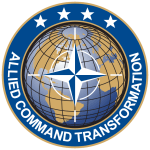 Emblem | |
| Founded | 19 June 2003 |
| Part of | North Atlantic Treaty Organisation |
| Headquarters | Naval Support Activity Hampton Roads Norfolk, Virginia |
| Commanders | |
| Current commander | Général André Lanata, French Air Force |
It was intended to lead military transformation of alliance forces and capabilities, using new concepts such as the NATO Response Force and new doctrines in order to improve the alliance's military effectiveness. Since France rejoined the NATO Military Command Structure in mid-2009, a significant change took place where the Supreme Allied Commander Transformation (SACT) became a French officer. The first French officer to serve as SACT was French Air Force General, Stephane Abrial (2009–2012).
History
Allied Command Atlantic 1952 to 2003
Allied Command Transformation was preceded by Allied Command Atlantic (ACLANT) established in 1952 under the overall command of Supreme Allied Commander Atlantic (SACLANT), with its headquarters at Norfolk, Virginia. ACLANT's purpose was to guard the Sea lines of communication between North America and Europe in order to reinforce the European countries of NATO with U.S. troops and supplies in the event of a Soviet/Warsaw Pact invasion of Western Europe. Following the end of the Cold War, the Command was reduced, with many of its subordinate headquarters spread across the Atlantic area losing their NATO status and funding. However, the basic structure remained in place until the Prague Summit in the Czech Republic in 2002. This led to ACLANT being decommissioned effective 19 June 2003, and a new Allied Command Transformation being established as its successor.[2]
Admiral Edmund P. Giambastiani Jr. US Navy became the last SACLANT on 2 October 2002. He served as ACLANT commander until 19 Jun 2003. He then served as Supreme Allied Commander, Transformation, until 1 Aug 2005. Admiral Sir Mark Stanhope RN, the Deputy Supreme Allied Commander, then served as Acting Supreme Allied Commander until the arrival of General Lance L. Smith USAF in November 2005.
After the Cold War
At the 2002 Prague Summit, it was decided that NATO should change its military structures and concepts, and acquire new types of equipment to face the operational challenges of coalition warfare against the threats of the new millennium. Thus NATO's military command structure was reorganized. One strategic command, Allied Command Transformation (ACT), was focused on transforming NATO, while the other strategic command focused on NATO's operations, Allied Command Operations (ACO/SHAPE). Initial reports about a NATO transformation command began to appear in July 2002.[3] ACT was formally established on June 19, 2003.
A suite of "Baseline for Rapid Iterative Transformational Experimentation" (BRITE) software was designed in response to the Maritime Situational Awareness request. This request, a product of a U.S. international and inter-agency initiatives termed "Maritime Domain Awareness," serves to counter threats to the maritime commons including terrorism, human/drug smuggling, piracy, and espionage.
Since Allied Command Atlantic became Allied Command Transformation, commanders have included non-naval officers. Gen. Lance L. Smith USAF commanded ACT from 10 Nov 2005 until 9 Nov 2007. He was succeeded by Gen. James N. Mattis USMC, who served from 9 Nov 2007 - 08 Sep 2009. A significant change was the assumption of command by a French officer, after France rejoined the NATO Command Structure in mid-2009. General Stéphane Abrial, former chief of the French Air Force assumed command in 2009. French Air Force General Jean-Paul Paloméros replaced Abrial at the end of September 2012. On 30 September 2015 French Air Force General Denis Mercier succeeded General Paloméros.
The Deputy Supreme Allied Commander Transformation position is currently filled by General Paolo Ruggiero of the Italian Army. He succeeded Admiral Manfred Nielson, German Navy, who succeeded General Mirco Zuliani of the Italian Air Force, General Mieczysław Bieniek of the Polish Land Forces, Admiral Luciano Zappata (Italian Navy)[4] and Admiral Stanhope. For several years, in a carryover from SACLANT, the Deputy's position was filled by a Royal Navy admiral. Stanhope's succession by Zappata meant an end to this practice.
Responsibilities
Allied Command Transformation's currentwhen? mission is to:
- provide the conceptual framework for the conduct of future combined joint operations;
- define how future operations will be conducted and what capabilities they will need;
- take new operational concepts, from others or self-generated, assess their viability and value, and bring them to maturity through doctrine development, scientific research, experimentation and technological development;
- implement both by persuading nations, individually and collectively, to acquire the capability, and provide the education and training, enabling concepts to be implemented by NATO forces.
A large number of conferences and seminars have been organised by the command in fulfilment of its conceptual development mission. These have included CD&E, a national Chiefs of Transformation conference, an examination of the Global Commons, Law of Armed Conflict, and a Multiple Futures project.[5]
Organization
The NATO Military Command Structure consists of two strategic commands directed by the North Atlantic Council:[6]
- Liaison: Provides advice and support to the NAC
| Political strategic level: | |||||||||||||||||||
| NATO SG (NAC) Brussels, BE | IS Brussels, BE | ||||||||||||||||||
| Military strategic level: | |||||||||||||||||||
CMC (NATO MC) | |||||||||||||||||||
 SACEUR (ACO, SHAPE) Mons, BE |  SACT (ACT, HQ SACT) Norfolk, US | ||||||||||||||||||
| Operational level: | |||||||||||||||||||
The command's headquarters is in Norfolk, Virginia, in the United States. HQ SACT itself is organised into a command group, the Transformation Directorate, the Transformation Support Directorate, National Liaison Representatives, the Partnership for Peace Staff Element and Reservists responsible to HQ SACT.
The Transformation Directorate is headed by the Deputy Chief of Staff (DCOS) Transformation who acts as the Supreme Allied Commander, Transformation's (SACT) Director for guidance and coordination of the activities of his or hers Directorate Transformation, divided in two divisions: Implementation and Capabilities. Within the full scale of SACT's transformational responsibilities the Deputy Chief of Staff (DCOS) Transformation assists the Chief of Staff (COS) in the execution of his or her duties with emphasis on deliverables to the Alliance Military Transformation Process in order to enhance NATO's operational capabilities and to meet NATO's future requirements.
The Implementation Division, led by Assistant Chief of Staff (ACOS) Implementation, is responsible for guidance and coordination of the activities of two Sub-Divisions, Joint Education and Training (JET) and Joint Experimentation, Exercises and Assessment (JEEA), as well as providing guidance for the Joint Warfare Centre (JWC) and Joint Analysis Lessons Learned Centre (JALLC), in their efforts to enhance training programs, to path on what does this mean? breaking concept development and experimentation, to develop effective programs to capture and implement lessons learned and to press on common standards. This division probablyis there some doubt? serves as NATO's linkpoint to the annual U.S.-led Coalition Warrior Interoperability Demonstration.
The Capabilities Division, led by Assistant Chief of Staff (ACOS) Capabilities, is responsible for guidance and coordination of the activities of three Sub-Divisions: of Strategic Concepts, Policy and Interoperability (SCPI); Future Capabilities, Research and Technology (FCRT) and Defence Planning (Def Plan) in their efforts to staff Capabilities, Concepts and Development products.
Subordinate commands
Reflecting NATO as a whole, ACT has a presence on both sides of the Atlantic.[7] Before the deactivation of United States Joint Forces Command, the two organisations were co-located, and indeed shared a commander for some time. There is an ACT command element located at SHAPE in Mons, Belgium. ACT's major subordinate commands are the Joint Warfare Centre (JWC) in Stavanger, Norway; the Joint Force Training Centre (JFTC) in Bydgoszcz, Poland; and the Joint Analysis and Lessons Learned Centre (JALLC) in Monsanto, Portugal.[8][9] Under a customer-funded arrangement, ACT invests about 30 million Euros into research with the NATO Communications and Information Agency (NCIA) each year to support scientific and experimental programs.
NATO Centres of Excellence
A Centre of Excellence (COE) offers recognised expertise and experience to the benefit of the Alliance, especially in support of transformation. Most are single-nation sponsored, but some are sponsored by multiple members. NATO has a total of 25 accredited COEs.[10] It provides opportunities to enhance education and training, to improve interoperability and capabilities, to assist in doctrine development and/or to test and validate concepts through experimentation. A COE is not a part of the NATO Military Command Structure, but their activities with NATO are coordinated through HQ ACT. Since COEs are predominantly multinational entities, most COEs are overseen by a steering committee (SC), that sets the programme of work and approves the budget for the COE.[11][12] The SC consists of one voting representative of each Sponsoring Nation (SN) and a various number of observers. All decisions are made by consensus.
Principles:
- No duplication or competition with existing NATO capabilities
- Nationally funded
- Conforms to NATO procedures, doctrines, standards and security policies
- Coordinated Programmes of Work provide guidance with inputs from both ACT and ACO organisations
NATO has the following fully accredited COEs:
- The Center for Analysis & Simulation for the Preparation of Air Operations Centre of Excellence (CASPOA) COE in Lyon – Mont Verdun Air Base, France
- The Civil-Military Cooperation Centre of Excellence (CIMIC) COE in The Hague, Netherlands
- The Cold Weather Operations Centre of Excellence (CWO) COE in Bodø, Norway
- Combined Joint Operations from the Sea Center of Excellence (CJOS-COE) in Norfolk, Virginia, United States.() The CJOS COE used to be a component of the United States Second Fleet.
- The Command & Control Centre of Excellence (C2) COE in Utrecht, Netherlands
- The Cooperative Cyber Defence Centre of Excellence in Tallinn, Estonia
- The Counter Improvised Explosive Devices Centre of Excellence (C-IED) COE in Madrid, Spain
- The Defence Against Terrorism Centre of Excellence (DAT) COE in Ankara, Turkey
- Energy Security (ENSEC) COE in Vilnius, Lithuania
- The Explosive Ordnance Disposal (EOD) COE in Trenčín, Slovakia
- The Human Intelligence Centre of Excellence (HUMINT) COE in Oradea, Romania
- The Joint Air Power Competence Center (JAPCC) COE in Kalkar, Germany. JAPCC is located at Von-Seydlitz-Kaserne, Römerstraße 140. D-47546 Kalkar. The JAPCC succeeds the Reaction Forces (Air) Staff, originally activated in 1993. The RFAS Memorandum of Understanding was terminated and all RFAS activities ceased on the formal activation of the Joint Air Power Competence Centre on 1 January 2005.[13]
- The Joint Chemical, Biological, Radiation, & Nuclear Defence Centre of Excellence (JCBRN Defence) COE in Vyškov, Czech Republic
- The Military Engineering Centre of Excellence (MILENG) COE in Ingolstadt, Germany
- The Military Medical Centre of Excellence (MILMED) COE in Budapest, Hungary
- The Modelling and Simulation (M&S) COE in Rome, Italy
- The Naval Mine Warfare Centre of Excellence (EGUERMIN) COE in Oostende, Belgium
- The Centre of Excellence for Operations in Confined and Shallow Waters in Kiel, Germany (supported by the German Navy's Einsatzflottille 1.)
- The Strategic Communications Centre of Excellence (STRATCOM) COE in Riga, Latvia[14]
- The Crisis Management for Disaster Response (CMDR) COE in Sofia, Bulgaria
- The NATO Military Police (MP) COE in Bydgoszcz, Poland
- NATO Mountain Warfare Centre of Excellence in Poljče, Slovenia
- NATO Stability Policing Centre of Excellence in Vicenza, Italy
- NATO Counter Intelligence Centre of Excellence in Krakow, Poland / Slovakia
- NATO Security Force Assistance (SFA) Centre of Excellence in Rome, Italy
- The Centre of Excellence for naval Visit, Board, Search and Seizure, NATO Maritime Interdiction Operational Training Centre (NMIOTC) [http://nmiotc.nato.int/, Souda Bay, Crete; supported by the Hellenic Navy.
Leadership
Supreme Allied Commander Transformation
| No. | Name | Picture | Began office | End office |
|---|---|---|---|---|
| 7 | Général d'armée Aérienne André Lanata (French Air Force) |
 |
11. September 2018 | |
| 6 | Général d'armée Aérienne Denis Mercier (French Air Force) |
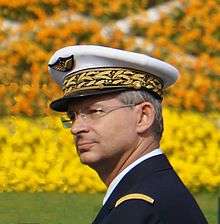 |
30. September 2015 | 11. September 2018 |
| 5 | Général d'armée Aérienne Jean-Paul Paloméros (French Air Force) |
28. September 2012 | 30. September 2015 | |
| 4 | Général d'armée Aérienne Stéphane Abrial (French Air Force) |
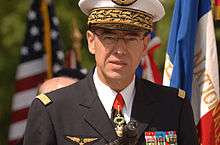 |
9. September 2009 | 28. September 2012 |
| 3 | General James N. Mattis (United States Marine Corps) |  |
9. November 2007 | 9. September 2009 |
| 2 | General Lance L. Smith (United States Air Force) | 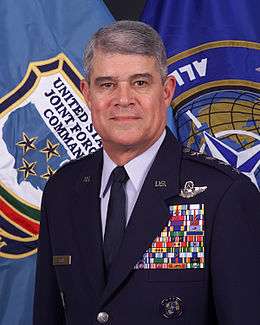 |
10. November 2005 | 9. November 2007 |
| 1 | Admiral Edmund P. Giambastiani (United States Navy) | 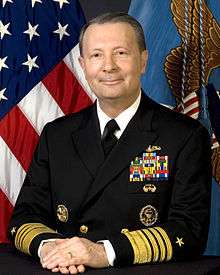 |
19. June 2003 | 19. June 2005 |
Deputy Supreme Allied Commander Transformation
| No. | Name | Picture | Began office | End office |
|---|---|---|---|---|
| 6 | Admiral Manfred Nielson (German Navy) |
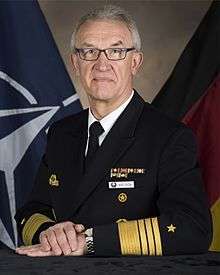 |
24. March 2016 | |
| 5 | General Mirco Zuliani (Italian Air Force) |
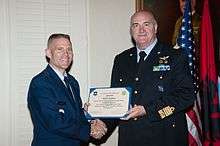 |
3. September 2013 | 24. March 2016 |
| 4 | General Mieczysław Bieniek (Polish Land Forces) |
29. September 2010 | 3. September 2013 | |
| 3 | Admiral Luciano Zappata (Italian Navy) | 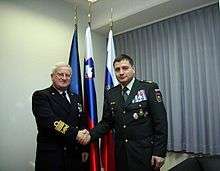 |
3. July 2007 | 29. September 2010 |
| 2 | Admiral Sir Mark Stanhope (Royal Navy) |  |
10. July 2004 | 3. July 2007 |
| 1 | Admiral Sir Ian Forbes (Royal Navy) | 1. July 2003 | 10. July 2004 | |
References
- "English and French shall be the official languages for the entire North Atlantic Treaty Organization." Final Communiqué following the meeting of the North Atlantic Council on 17 September 1949 Archived 6 December 2006 at the Wayback Machine. "... the English and French texts [of the Treaty] are equally authentic ..." The North Atlantic Treaty, Article 14 Archived 14 September 2011 at the Wayback Machine
- "New NATO Transformation Command Established in Norfolk". American Forces Press Service. United States Department of Defense. 19 June 2003. Archived from the original on 17 September 2008. Retrieved 2008-09-09.
- Colin Robinson, 'NATO's Command Structure Prepares for Shakeup', Center for Defense Information, 2 July 2002.
- Outgoing NATO deputy commander has seen growing pains, Virginian-Pilot, July 3, 2007
- "NATO ACT". www.act.nato.int.
- "Command Structure" (PDF). NATO. Retrieved 19 October 2019. and "Military Command Structure". shape.nato.int. Supreme Head Allied Powers Europe. 12 February 2020. Retrieved 12 February 2020.
- Allied Command Transformation, ACT History Archived 2012-06-25 at the Wayback Machine, accessed November 2012
- "Who We Are". Allied Command Transformation. Retrieved 24 February 2017.
- "Nato Centres of Excellence".
- "Centres of Excellence".
- "NATO Energy Security Centre of Excellence". Archived from the original on November 18, 2013. Retrieved November 18, 2013.
- "7th Steering Committee Meeting". Coemed.org. 2012-05-15. Archived from the original on 2017-08-24. Retrieved 2014-06-14.
- verified September 2008
- Charlotte McDonald-Gibson (14 January 2015). "Battle in cyberspace: Nato plans to help the West win the information war with Russia". The Independent. Retrieved 8 February 2017.
External links
| Wikimedia Commons has media related to North Atlantic Treaty Organisation. |
